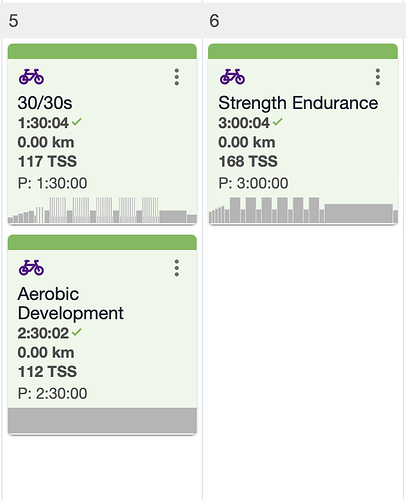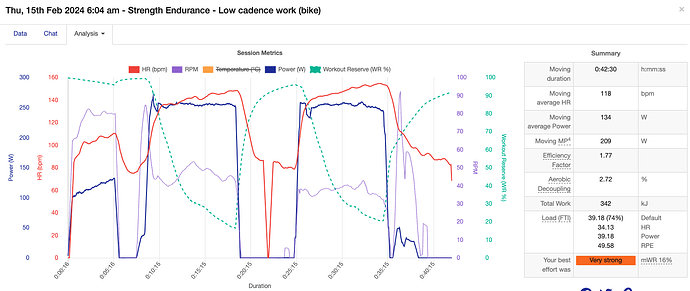Alternate cadence within a session is a great idea too. But much shorter intervals. Think of 2m at high tempo (275) and 60 rpm and 1m at threshold (320) and 100 rpm, repeated, say, 10 times. So above example is 30 mins (no recovery within). Follow up with your 10m SS then. Difficult sessions!!
Your question reminded me of these training plans from Kreitler that incorporate cadence into the workout. I find these great for developing higher cadence/smooth pedaling needed for track racing. I have been using some of these on my rollers at home over the last couple years on days where i’m not at the track and can’t ride outside.
That sounds absolutely horrific! But also like a very efficient way of becoming very punchy (and I am already a punchy rider, and I like fine tuning the things where I can easily gain edges on others).
Would you correct for someone having a natural inclination towards higher cadence? Eg. 70rpm and 110rpm instead?
The purpose of the low cadence work is to get the intermediate fibers (IIa) to work aerobically. Low cadence work produces less lactate then higher cadence at the same power. Two-day blocks of micro-intervals (30/30’s) followed by low-cadence work seem to be popular. I’ve observed this structure utilized by Join Cycling and Athletica.ai.
Thank you, this is exactly the response I was looking for (without even knowing it). Do you have the exact contents of those workouts?
Also, do you know if (or rather, how) cadence should be adjusted for athletes already tending towards the higher side of the cadence-spectrum? Ie. my “normal” cadence is usually around 100rpm (often slightly higher) and currently 90-100 (a wide spectrum, I know) seems to be where my hr is most stable/relaxed and even where I recover the best (at least during races and between harder efforts). So I am uncertain if I should train low cadence a bit higher than most other athletes (eg. 70 instead of 60).
Again, thank you for the precise and on point response. It is very helpful.
All the best,
Niklas
I don’t, I’m sorry. There’s nothing wrong with going by feel though. I would say starting higher would be advisable anyway due to potential for knee issues in some cases. Then work your way down if your knees are good. I had a hard time getting all the way down to 60 rpm myself.
Like anything else, you’ll get better at execution as you do the workout. Good luck!
I’m a big believer of cadence variability workouts. If you don’t train it, chances are you won’t get the benefits.
From my experience, I respond very well to high rpm stimulation and many of the athletes I coach.
JM
I think that tracks well with other’s personal experiences. That happens to be the way that many riders obtain their incorrect ftp, by running the test at the wrong, lower, cadence.
From my observations which are by no means scientific, many riders are caught up in chasing ftp numbers. Then, often enough, we hear about those riders not being able to maintain their ftp number for 20 minutes, never mind an hour.
As we know, ftp is not just power, but an approximation of the lactate threshold whereby the body is at equilibrium producing and metabolizing or flushing lactate from the muscles. And that involves cardiovascular processes. FTP is a point at which the two are at equilibrium. That will disconnect over a ride, but takes longer as a rider obtains better fitness.
A lower cadence is absolutely the way to increase ftp numbers or any other power numbers while cycling. That’s why FTP tests I’ve seen recommend a cadence as well as a power number. Power without cardio to back it up is weak.
Unless you’re Harrie Lavreysen ![]()
Seriously though…completely agree with you even in track sprinting scenarios.
Whoa. So looked him up on YouTube. There a video of him leg pressing 600 kg. Hitting 70kmh is most impressive. I hadn’t ever followed those events. Very good find. Ty .
Thanks for raising this @Andrew_J_Cerniglia & @Niklas_Birksted . If anyone is keen to understand more on this Dr Dajo Sanders from Team Ineos Grenadiers came on my podcast to describe why you want this in your training diet as a cyclist. If you start listening from almost exactly 1 hour of the podcast you’ll hear a 6 min explanation from Dajo around what top coaches are doing in this space and why. Basically yes - you make your large powerful FT fibres more aerobic. Note that you don’t do this with sprinters for the same reverse reason.
Short recreational level example session here…
Listen to your podcast the other day. Very interesting discussion!
JM

